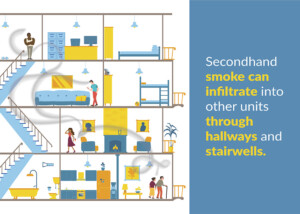 The REACH strategy to address the harm associated with secondhand smoke is to educate tenant’s living in multi-unit housing communities. In addition, we intend to work with tenants and landlords on the adoption of smoke-free policies and to create healthier communities. Secondhand smoke harms children and adults, and the only way to fully protect nonsmokers is to eliminate smoking in all homes, worksites, and public places. Separating smokers from nonsmokers, opening windows, or using air filters does not prevent people from breathing secondhand smoke. People with lower income and lower education are less likely to be covered by smoke-free laws in worksites, restaurants, and bars.
The REACH strategy to address the harm associated with secondhand smoke is to educate tenant’s living in multi-unit housing communities. In addition, we intend to work with tenants and landlords on the adoption of smoke-free policies and to create healthier communities. Secondhand smoke harms children and adults, and the only way to fully protect nonsmokers is to eliminate smoking in all homes, worksites, and public places. Separating smokers from nonsmokers, opening windows, or using air filters does not prevent people from breathing secondhand smoke. People with lower income and lower education are less likely to be covered by smoke-free laws in worksites, restaurants, and bars.
What Is Secondhand Smoke?
- Secondhand smoke is smoke from burning tobacco products, such as cigarettes, cigars, or pipes.
- Secondhand smoke also is smoke that has been exhaled, or breathed out, by the person smoking.
- Tobacco smoke contains more than 7,000 chemicals, including hundreds that are toxic and about 70 that can cause cancer.
There is no risk-free level of secondhand smoke exposure; even brief exposure can be harmful to health. Since 1964, approximately 2,500,000 nonsmokers have died from health problems caused
Health Effects In Children
In children, secondhand smoke causes the following:
- Ear infections
- More frequent/severe asthma attacks
- Respiratory symptoms (coughing, sneezing, and shortness of breath)
- Respiratory infections (bronchitis and pneumonia)
- A greater risk for sudden infant death syndrome (SIDS)
Health Effects In Adults
In adults who have never smoked, secondhand smoke can cause:
- Heart disease – for nonsmokers, breathing secondhand smoke has immediate harmful effects on the heart and blood vessels. It is estimated that secondhand smoke caused nearly 34,000 heart disease deaths each year during 2005–2009 among adult nonsmokers in the United States.
- Lung cancer – secondhand smoke exposure caused more than 7,300 lung cancer deaths each year during 2005–2009 among adult nonsmokers in the United States.
- Stroke
What You Can Do
You can protect yourself by:
- Quitting smoking if you are not already a nonsmoker
- Not allowing anyone to smoke anywhere in or near your home
- Not allowing anyone to smoke in your car, even with windows down
- Making sure your children’s day care center and schools are tobacco-free
- Seeking out restaurants and other places that do not allow smoking (if your state still allows smoking in public areas)
- Teaching your children to stay away from secondhand smoke
- Being a role model by not smoking or using any other type of tobacco
For support in quitting call:
1-800-QUIT-NOW (1-800-784-8669)
1-855-DÉJELO-YA (1-855-335-3569)
You can also visit our resources page or download the quitSTART app to help you stop smoking now. The free smartphone app helps you quit smoking with tailored tips, inspiration, and challenges. Download it to your phone by clicking below!


